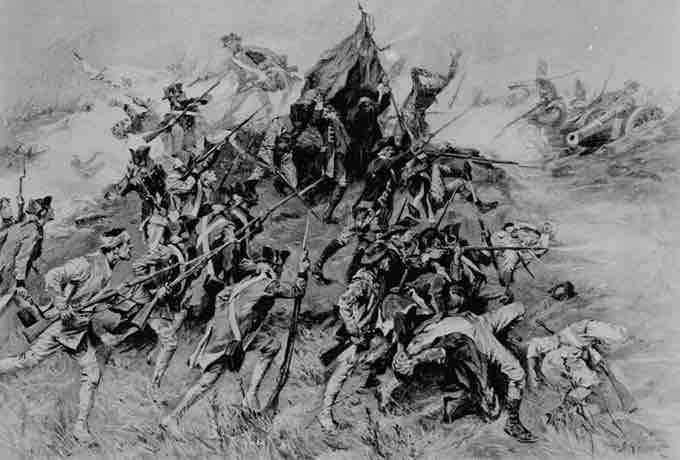In 1778, the British turned their attention to the South, hoping to draw upon a strong Southern Loyalist base. Expectations for this support base were fueled by accounts of Loyalist exiles in London who had direct access to the American Secretary, George Germain. Keen to recover their lands, exiles exaggerated the level of potential Loyalist support in the South to encourage the British to undertake a major operation in the Southern colonies.
The misconception that the British would eventually find substantial support for their actions in the South held until the final days of the war. As evidence of this, British General Charles Cornwallis stated in an 1780 message to his superior officer that, "Our assurances of attachment from our poor distressed friends in North Carolina are as strong as ever." As the British campaign in the South progressed, this assumption was shown to be incorrect.
In addition to looking for Loyalist support, Britain also hoped to "scare" Americans back to the crown by raising fear of massive slave revolts. As a part of the Southern Strategy, the British encouraged slaves to flee to their strongholds, promising them freedom. The strategy backfired, but tens of thousands of African Americans sought refuge with the British, and at the conclusion of the war, some 20,000 African Americans left with the British, preferring an uncertain future elsewhere to a return to their old masters. African Americans ended up in Canada, Britain, the West Indies, and Europe. In 1792, 1,200 black Loyalists who had settled in Nova Scotia left for Sierra Leone, a colony on the west coast of Africa established by Britain specifically for former slaves.
Engagements in Savannah
On December 29, 1778, a British expeditionary corps of 3,500 men from New York under the command of Lieutenant Colonel Archibald Campbell captured Savannah, Georgia. In October 1779, French and Revolutionary forces attempted to retake Savannah. Under the leadership of General Benjamin Lincoln, this effort was a spectacular failure with combined French-American forces suffering approximately 900 casualties compared to 50 British casualties. With Savannah secured, British Commander-in-Chief Henry Clinton launched a new assault on Charleston, South Carolina, which he had failed to capture in 1776.
Major Operations in the South, 1780-1781
Clinton moved against Charleston in 1780, blockading the harbor in March and bringing 10,000 troops to the area. His advance on the city was uncontested. Inside the city, General Lincoln commanded approximately 2,650 Continentals and 2,500 militiamen. In early March, Clinton began constructing siege lines and commenced bombardment of the town.
On May 12, 1780, General Lincoln surrendered 5,000 men—the largest surrender of U.S. troops prior to the American Civil War. With relatively few casualties, Clinton had seized the South's biggest city and seaport, winning perhaps the greatest British victory of the war. The loss of the city and its troops was a serious blow to the American cause because it temporarily collapsed American military operations in the South. Following the victory at Charleston, General Clinton turned over British operations in the South to his second-in-command, Lord Cornwallis.
The Continental Congress responded to the fall of Charleston by dispatching General Horatio Gates, a celebrated hero in the Battle of Saratoga, to the South with a new army. However, Gates promptly suffered one of the worst defeats in U.S. military history at the Battle of Camden in South Carolina on August 16, 1780. This loss set the stage for Cornwallis to invade North Carolina.
The success of Cornwallis in the Carolinas was greatly undermined by Britain's inability to raise large Loyalist armies. Too few Loyalists enlisted, and those who did were left isolated and vulnerable once the British army moved out of their territory. British attempts to raise Loyalists in North Carolina were effectively crushed when a Patriot militia defeated a large force of Loyalists in the Battle of Kings Mountain on October 7, 1780.
General Gates was replaced by George Washington's most dependable subordinate, Continental General Nathanael Greene. Greene proceeded to wear down his opponents in a series of operations referred to as the "Race to the Dan", named for the Dan River that flows near the border between North Carolina and Virginia. In the "Race to the Dan", the British won many tactical victories, none of which culminated in any broad strategic advantage. In almost all cases, the "victories" strategically weakened the British army due to large numbers of casualties, leaving the Continental Army intact to continue fighting.
In the late spring of 1781, Greene led the Siege of Ninety Six in an attempt to secure the village of Ninety Six, South Carolina. Though unsuccessful, the actions of Greene and allied militia commanders led the weakened British forces to abandon Ninety Six and Camden, effectively reducing the British presence in South Carolina to the port of Charleston. The final major battle of the Carolinas took place in Eutaw Springs, South Carolina, on September 1781. Nathanael Greene, supported by 2,600 troops, engaged 2,000 British forces under Lieutenant Colonel Alexander Stewart. Though the tactical victor of the Battle of Eutaw Springs is contested, this engagement so weakened the British that they withdrew to Charleston, where Greene held them for the remaining months of the war.

Siege of Savannah
Attack on Savannah by A. I. Keller.